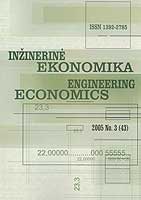Application of Internal Audit in Enterprise Risk Management
Application of Internal Audit in Enterprise Risk Management
Author(s): Romas Stačiokas, Rolandas RupšysSubject(s): Business Economy / Management, Accounting - Business Administration
Published by: Kauno Technologijos Universitetas
Keywords: internal audit; internal audit functions; business risk; enterprise risk management;
Summary/Abstract: Internal audit has been used in enterprises and public institutions management for a long time. Application of internal audit may be implemented by external regulations (e.g. recent changes in the New York Stock Exchange rules or Sarbanes-Oxley Act of 2002 in U.S.) or by entity itself on the purpose to improve its operations. Depending on the industry organization is acting, nature and complexion of organization and other factors, internal audit function may be used toward various directions. In financial institutions (banks, insurance companies, etc.) the need for the internal audit activity is expressed over objective to assure cash flows, liquidity of the institution and safeguarding of the assets. On the opposite, in manufacturing companies internal audit function will be related with operational process improvement, supply management analysis or efficient use of assets. Public institutions (local governments, public service companies) will pay attention over effective and efficient use of funds and compliance with regulations; therefore there is a demand mainly for compliance audit in such institutions. At present internal audit is used in all industry types and covers many areas: starting from attitude on accounting and financial information, assessment of internal controls and operating activities and ending with consultations to the senior management regarding strategic issues and risk management. This article covers the survey of internal audit interpretations, internal audit functions and the role of internal audit in enterprise risk management. Many international leading companies have recognized value of the enterprise risk management model that allows managing enterprise risks as a respond to rapid environmental changes. Currently enterprise risk management became the most progressive area of studies for scientists specializing in risk management. Comprehensive simulation of enterprise risk management with incorporation of separate parts of other subjects (such as internal audit, finance management, etc.) is making only the first steps on the scientific arena and moves this issue to further discussions and scientific studies.
Journal: Engineering Economics
- Issue Year: 2005
- Issue No: 2 (42)
- Page Range: 20-25
- Page Count: 6
- Language: English

